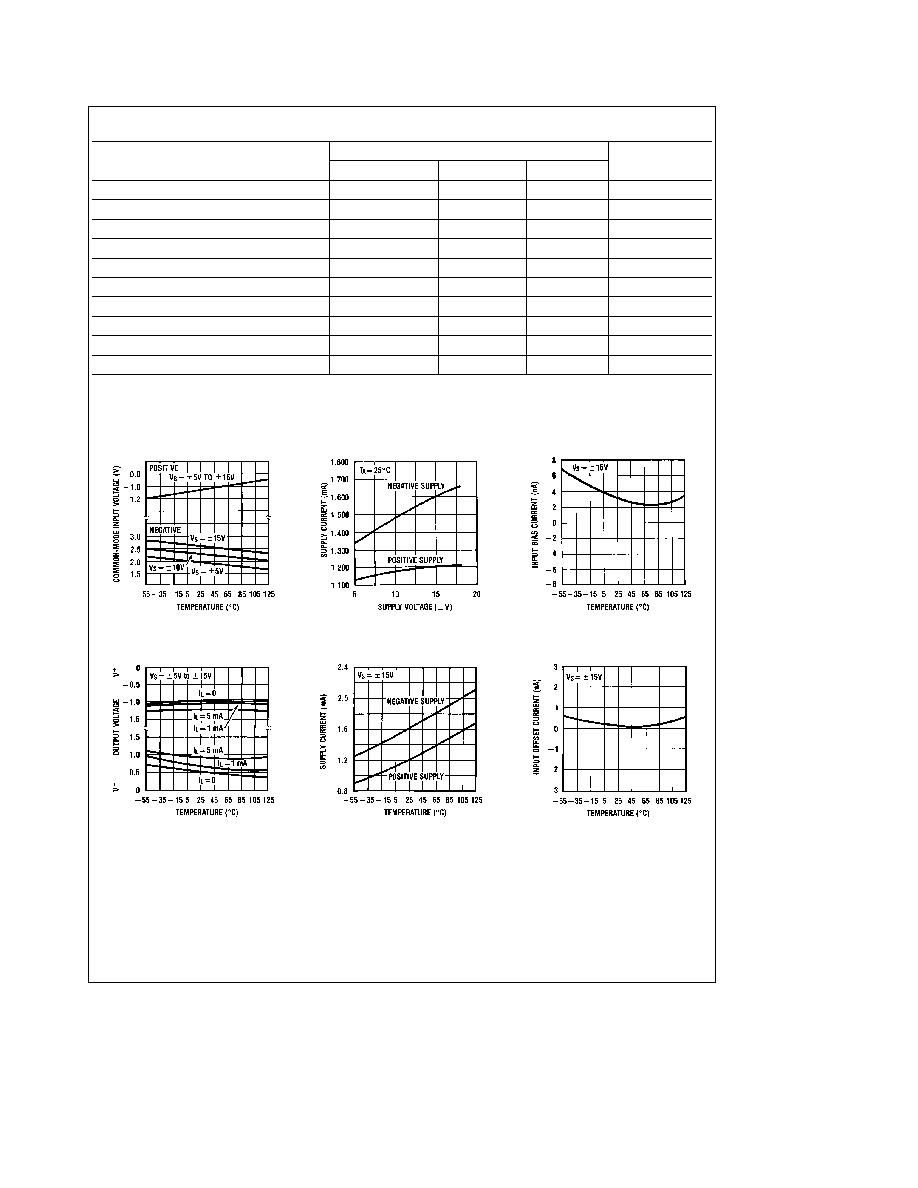 | –≠–ª–µ–∫—Ç—Ä–æ–Ω–Ω—ã–π –∫–æ–º–ø–æ–Ω–µ–Ω—Ç: 363D | –°–∫–∞—á–∞—Ç—å:  PDF PDF  ZIP ZIP |

TL H 5609
LM363
Precision
Instrumentation
Amplifier
April 1991
LM363 Precision Instrumentation Amplifier
General Description
The LM363 is a monolithic true instrumentation amplifier It
requires no external parts for fixed gains of 10 100 and
1000 High precision is attained by on-chip trimming of off-
set voltage and gain A super-beta bipolar input stage gives
very low input bias current and voltage noise extremely low
offset voltage drift and high common-mode rejection ratio
A two-stage amplifier design yields an open loop gain of
10 000 000 and a gain bandwidth product of 30 MHz yet
remains stable for all closed loop gains The LM363 oper-
ates with supply voltages from
g
5V to
g
18V with only
1 5 mA current drain
The LM363's low voltage noise low offset voltage and off-
set voltage drift make it ideal for amplifying low-level low-
impedance transducers At the same time its low bias cur-
rent and high input impedance (both common-mode and
differential) provide excellent performance at high imped-
ance levels These features along with its ultra-high com-
mon-mode rejection allow the LM363 to be used in the
most demanding instrumentation amplifier applications re-
placing expensive hybrid module or multi-chip designs Be-
cause the LM363 is internally trimmed precision external
resistors and their associated errors are eliminated
The 16-pin dual-in-line package provides pin-strappable
gains of 10 100 or 1000 Its twin differential shield drivers
eliminate bandwidth loss due to cable capacitance Com-
pensation pins allow overcompensation to reduce band-
width and output noise or to provide greater stability with
capacitive loads Separate output force sense and refer-
ence pins permit gains between 10 and 10 000 to be pro-
grammed using external resistors
On the 8-pin metal can package gain is internally set at 10
100 or 500 but may be increased with external resistors
The shield driver and offset adjust pins are omitted on the
8-pin versions
The LM363 is rated for 0 C to 70 C
Features
Y
Offset and gain pretrimmed
Y
12 nV
0
Hz input noise (G
e
500 1000)
Y
130 dB CMRR typical (G
e
500 1000)
Y
2 nA bias current typical
Y
No external parts required
Y
Dual shield drivers
Y
Can be used as a high performance op amp
Y
Low supply current (1 5 mA typ)
Typical Connections
8-Pin Package
TL H 5609 ≠ 1
16-Pin Package
G
e
10 2 3 4 open
G
e
100 3≠4 shorted
G
e
1000 2≠4 shorted
TL H 5609 ≠ 33
Connection Diagrams
Metal Can Package
16-Pin Dual-In-Line Package
TL H 5609 ≠ 2
Order Number LM363H-10
LM363H-100 or LM363H-500
See NS Package Number H08C
Order Number 363D
See NS Package Number D16C
C1995 National Semiconductor Corporation
RRD-B30M115 Printed in U S A

Absolute Maximum Ratings
(Note 5)
If Military Aerospace specified devices are required
please contact the National Semiconductor Sales
Office Distributors for availability and specifications
Supply Voltage
g
18V
Differential Input Voltage
g
10V
Input Current
g
20 mA
Input Voltage
Equal to Supply Voltage
Reference and Sense Voltage
g
25V
Lead Temp (Soldering 10 sec )
300 C
ESD rating to be determined
LM363 Electrical Characteristics
(Notes 1 and 2)
LM363
Parameter
Conditions
Tested
Design
Units
Typ
Limit
Limit
(Note 3)
(Note 4)
FIXED GAIN (8-PIN)
Input Offset Voltage
G
e
500
30
150
400
m
V
G
e
100
50
250
700
m
V
G
e
10
0 5
2 5
6
mV
Input Offset Voltage Drift
G
e
500
1
4
m
V C
G
e
100
2
8
m
V C
G
e
10
20
75
m
V C
Gain Error
G
e
500
0 1
0 8
0 9
%
(
g
10V Swing 2 kX Load)
G
e
100
0 07
0 7
0 8
%
G
e
10
0 05
0 6
0 7
%
PROGRAMMABLE GAIN (16-PIN)
Input Offset Voltage
G
e
1000
50
250
500
m
V
G
e
100
100
450
900
m
V
G
e
10
1
3 5
8
mV
Input Offset Voltage Drift
G
e
1000
1
5
m
V C
G
e
100
2
10
m
V C
G
e
10
10
100
m
V C
Gain Error
G
e
1000
2 0
3 0
3 5
%
(
g
10V Swing 2 kX Load)
G
e
100
0 1
0 7
0 8
%
G
e
10
0 6
2 0
2 3
%
FIXED GAIN AND PROGRAMMABLE
Gain Temperature Coefficient
G
e
1000
40
ppm C
G
e
500
20
ppm C
G
e
100 10
10
ppm C
Gain Non-Linearity
G
e
10 100
0 01
0 03
0 04
%
(
g
10V Swing 2 kX Load)
G
e
500 1000
0 01
0 05
0 06
%
2

LM363 Electrical Characteristics
(Continued) (Notes 1 and 2)
LM363
Parameter
Conditions
Tested
Design
Units
Typ
Limit
Limit
(Note 3)
(Note 4)
Common-Mode Rejection
G
e
1000 500
130
114
104
dB
Ratio (
b
10V
s
V
CM
s
10V)
G
e
100
120
94
84
dB
G
e
10
105
90
80
dB
Positive Supply Rejection
G
e
1000 500
130
110
100
dB
Ratio (5V to 15V)
G
e
100
120
100
95
dB
G
e
10
100
85
78
dB
Negative Supply Rejection
G
e
1000 500
120
100
90
dB
Ratio (
b
5V to
b
15V)
G
e
100
106
85
75
dB
G
e
10
86
70
60
dB
Input Bias Current
2
10
20
nA
Input Offset Current
1
3
5
nA
Common-Mode Input
100
8
GX
Resistance
Differential Mode Input
G
e
1000 500
0 2
GX
Resistance
G
e
100
2
GX
G
e
10
20
GX
Input Offset Current Change
b
11V
s
V
CM
s
13V
20
100
300
pa V
Reference and Sense
50
kX
Resistance
Min
30
27
kX
Max
80
83
kX
Open Loop Gain
G
CL
e
1000 500
10
1
V mV
Supply Current
Positive
1 2
2 4
3 0
mA
Negative
1 6
2 8
3 4
mA
Note 1
These conditions apply unless otherwise noted V
a
e
15V V
b
e b
15V V
CM
e
0V R
L
e
2 kX reference pin grounded sense pin connected to output and
T
j
e
25 C
Note 2 Boldface limits are guaranteed over full temperature range
Operating ambient temperature range is 0 C to 70 C for the LM363
Note 3
Guaranteed and 100% production tested
Note 4
Guaranteed but not 100% tested These limits are not used in determining outgoing quality levels
Note 5
Maximum rated junction temperature is 100 C for the LM363 Thermal resistance junction to ambient is 150 C W for the TO-99(H) package and 100 C W
for the ceramic DIP (D)
3

Typical Performance Characteristics
T
A
e
25 C
Parameter
Fixed Gain and Programmable
Units
1000 500
100
10
Input Voltage Noise rms 1 kHz
12
18
90
nV
S
Hz
Input Voltage Noise (Note 6)
0 4
1 5
10
m
Vp-p
Input Current Noise rms 1 kHz
0 2
0 2
0 2
pA
S
Hz
Input Current Noise (Note 6)
40
40
40
pAp-p
Bandwidth
30
100
200
kHz
Slew Rate
1
0 36
0 24
V ms
Settling Time 0 1% of 10V
70
25
20
m
s
Offset Voltage Warm-Up Drift (Note 7)
5
15
50
m
V
Offset Voltage Stability (Note 8)
5
10
100
m
V
Gain Stability (Note 8)
0 01
0 005
0 05
%
Note 6
Measured for 100 seconds in a 0 01 Hz to 10 Hz bandwidth
Note 7
Measured for 5 minutes in still air V
a
e
15V V
b
e b
15V Warm-up drift is proportionally reduced at lower supply voltages
Voltage Limit
Common-Mode Input
Voltage
Supply Current vs Supply
Temperature
Input Bias Current vs
Supplies
Output Swing Referred to
Temperature
Supply Current vs
Temperature
Input Offset Current vs
TL H 5609 ≠ 3
4

Typical Performance Characteristics
(Continued)
Output Current Limit
Input Noise Voltage
Input Current Noise
Input Current vs Voltage
Overdrive
Gain Non-Linearity
Gain Error vs Frequency
Trimmed to zero at 100 Hz
Positive Power Supply
Negative Power Supply
Gain Error vs Frequency
Rejection
Rejection
Trimmed to zero at 100 Hz
Negative Power Supply
Negative Power Supply
Negative Power Supply
Rejection
Rejection
Rejection
TL H 5609 ≠ 4
5




